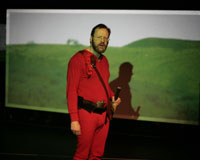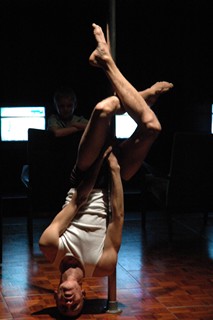No More Drama
Reviewed by Fintan Walsh Published 11 November
Without an interrogative or a subtitle, Crawley and White’s edited volume of essays on contemporary theatre practice risks resounding with the force of an order: ‘NO MORE DRAMA’ they insist. But in borrowing the title from a Mary J. Blige hit, the collection is more playfully inflected than this, and as the carefully commissioned writings cumulatively reveal, less interested in barring drama from our stages altogether, than creating space for other theatrical features and phenomena to shine. In this beautifully designed paperback, these ideas are explored by an international chorus of academics, critics, curators and theatre-makers whose voices make up the eleven core essays, which are illuminated at intervals by full-colour photographic inserts.
In the introductory essay, Crawley defends the seemingly negative slant of the book’s proposition, by maintaining that the work considered resists easy definition, insofar as it fundamentally grates against norms: ‘Sometimes described as postdramatic theatre, documentary theatre, or live art, this work does not begin with a writer or take a dramatic text as its basis. Rarely does it ask its performers to inhabit characters, or its audience to believe they are somewhere other than a performance space.’ (p.11) While Hans-Thies Lehman’s influential study Postdramatic Theatre (1999; trans. 2006) clearly informs the critical background to the anthology and its selected case studies, what links the entries most intimately together is undoubtedly their shared interest in theatre that decenters text, and performance that questions the principle of representation as imitation, a central tenet of the Western dramatic tradition. Featuring essays on the work of Elevator Repair Service, Oklahoma, Pan Pan, Richard Maxwell and the New York City Players, Rimini Protokoll and Quarantine, to name a handful, the work centralized here does not ask us to suspend disbelief when it comes to character, place, plot or time; rather it undermines this convention, and uses the impossibility of pretence as the basis for experimentation.
Discussing the only Irish company profiled in the book, Noelia Ruiz offers a very useful survey of Pan Pan’s oeuvre, historicizing the company’s progression since it was founded in 1991, stressing its relationship to European art and thought. Ruiz’s perspectives are interspersed with sizable quotes from Gavin Quinn, which were presumably collected in interview. The inclusion of four photographs by Ros Kavanagh helps to foreground the powerful visual appeal of Pan Pan’s aesthetic, with an image of the Chinese production of The Playboy of the Western World (2006) making the front cover, although the intricacies of that production’s cultural politics are not directly broached.
 Ruiz compares Pan Pan’s affectless playing style to that of Richard Maxwell and the New York City Players, who brought People Without History to the Project Arts Centre in 2010. In her analysis of the group, Sarah Gorman confesses to being confounded by the shifts she observes in the work. Although the company are noted for a low-key playing style, Gorman chronicles how the work has changed over time, and the manner in which it continues to resist easy understanding: ‘Just when I think “I have got it,” she writes of Maxwell, ‘he presents something which is a dramatic departure from what went before.’ (p.181) While providing both an ample overview and assessment of Maxwell’s work and its challenges, on a broader level Gorman’s piece implicitly alerts us to some of the ways in which contemporary theatre that does not seem overtly political still manages to pose fascinating questions about celebrity, satisfaction and value which are so pertinent to our time.
Ruiz compares Pan Pan’s affectless playing style to that of Richard Maxwell and the New York City Players, who brought People Without History to the Project Arts Centre in 2010. In her analysis of the group, Sarah Gorman confesses to being confounded by the shifts she observes in the work. Although the company are noted for a low-key playing style, Gorman chronicles how the work has changed over time, and the manner in which it continues to resist easy understanding: ‘Just when I think “I have got it,” she writes of Maxwell, ‘he presents something which is a dramatic departure from what went before.’ (p.181) While providing both an ample overview and assessment of Maxwell’s work and its challenges, on a broader level Gorman’s piece implicitly alerts us to some of the ways in which contemporary theatre that does not seem overtly political still manages to pose fascinating questions about celebrity, satisfaction and value which are so pertinent to our time.
More directly searching for the political in performance, Jacob Wren weaves a quirky discussion from the philosophy of Giorgio Agamben, his experience as a member of the Montreal performance group PME-ART, and his thoughts on contemporary art. While Fintan O’Toole has recently conflated political theatre in Ireland with the great, big ‘power play’, Wren is more suspicious of the virtuosic, and associates political agency with theatre’s ‘shaggy, fumbling (slightly paranoid)’ nature, and its ability to make us feel like the world order is not yet fixed. The politics of the theatre event, Wren suggests, circulates around the problem shared between the performers and the audience of ‘how to honestly face the inherently fragile, vulnerable nature of the situation?’ (p.65) You could say that a similar question structured much of the Irish work at this year’s Ulster Bank Dublin Theatre Festival during which the book was launched, in particular ANU’s Laundry, Brokentalkers The Blue Boy, THEATREclub’s Heroin and THISISPOPBABY’s Trade.
In another particularly interesting contribution, Florian Malzacher evaluates the role of curatorship in the performing arts. Historically more closely associated with the visual arts, Malzacher diagnoses the emergence of a curatorial role in contemporary theatre as a ‘symptom’ of changes taking place in performance practice since the 1980s. A practicing curator himself, Malzacher argues that a model of curatorship - rather than artistic directorship, for instance – offers a way for arts leaders to begin thinking about dramaturgy that involves no drama, dancing that has little recognizable dance, and theatre that has no text. Fundamentally, his essay suggests that the idea of curatorship offers a fresh way of engaging the multiple challenges faced in programming contemporary theatre.
 The breadth of roles and networks possible in contemporary theatre is made vividly apparent in the essay on the UK based Quarantine, in which no less than twenty voices are drawn into dialogue. From the group who brought Susan and Darren to the Dublin Fringe Festival in 2008 this entry is both a reflection and an example of the company’s collaborative working methods and its charming appeal. While core members Richard Gregory, Renny O’Shea and Simon Banham admit to being primarily interested in dealing with ‘mundane and familiar’ subjects and relationships – what Rimini Protokoll refer to as ‘everyday experts’ - they also see their work as an ongoing conversation with audiences, participants and collaborators. For Lesa Dryburgh, this ultimately achieves the impact of ‘brutal honesty, beautifully presented’. (p. 230)
The breadth of roles and networks possible in contemporary theatre is made vividly apparent in the essay on the UK based Quarantine, in which no less than twenty voices are drawn into dialogue. From the group who brought Susan and Darren to the Dublin Fringe Festival in 2008 this entry is both a reflection and an example of the company’s collaborative working methods and its charming appeal. While core members Richard Gregory, Renny O’Shea and Simon Banham admit to being primarily interested in dealing with ‘mundane and familiar’ subjects and relationships – what Rimini Protokoll refer to as ‘everyday experts’ - they also see their work as an ongoing conversation with audiences, participants and collaborators. For Lesa Dryburgh, this ultimately achieves the impact of ‘brutal honesty, beautifully presented’. (p. 230)
Although NO MORE DRAMA offers a rich collection of analyses of contemporary theatre across the globe, its provocation within the context of Irish culture is not directly articulated. The volume is by no means about Irish theatre, nor is its target audience necessarily Irish. Yet an Irish connection binds the book together: its editors, its press, its place of publication and the fact that almost all of the artists referred to have performed in Ireland at some point.
The editors’ decision not to explicitly outline the book’s relationship to any geographical, national or cultural context performs a number of interesting functions. On a practical level, it allows the broad range of essays to be more accessible to a wide range of readers, who may dip in and out of discrete entries, without needing to worry about a master discourse, which the theatre under consideration might already be seen to resist. The impulse in Irish critical culture to measure even the most experimental theatrical gesture against the convenient benchmark of literary drama, for better or worse, is short-circuited here by refusing to openly discuss the book’s intervention in Irish theatre. Instead, the pieces are left to bob gently next to one other in a way that evokes some of the frisky playing styles at the heart of the anthology’s focus.
If the collection is not about Irish theatre then, we might ask what its editors – who, between them, have significant critical and curatorial influence in Ireland – are at least hinting at the local community? Certainly, the book acts as wonderful record of touring productions that have taken place on Dublin stages over the past decade. Implicitly, the volume expresses an appreciation of work that isn’t subservient to the dramatic text but at least plays with it in performance, interrogating the inherited rules of theatrical representation. It’s fair to surmise, I think, that Crawley and White have curated the literary version of their dream festival programme, and this is reflected in the generous tone with which the work is platformed. Beyond this, we might also see in the book a wish that the spirit if not the style of the work accounted for be embraced and developed in Ireland. As this year’s Ulster Bank Dublin Theatre Festival revealed, many of the theatre companies which were established in the past decade are already able to hold their own next to international standards. Reading this book, then, one also feels that it begs for a companion piece in which the relatively recent, exciting developments in contemporary Irish theatre and performance practice might be studied and celebrated with equal enthusiasm.
NO MORE DRAMA is a one of those rare books that is as aesthetically pleasing as it is conceptually compelling, readable as it is challenging. In bringing together an extraordinary range of observers and makers of theatre, it will not only interest academics, critics, curators and theatre-makers, but anyone with an interest in contemporary theatre practice, pre- or post-dramatic.